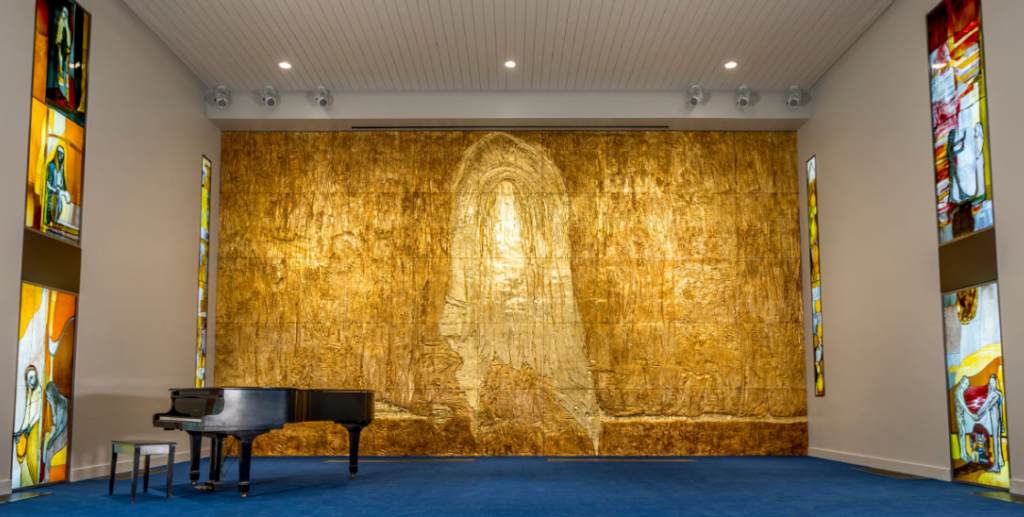A scene from The Canterbury Psalter (12th century)
Blog
The Risen One Here and Now

A few remarks I made at a ceremony for the five-year anniversary of the artistic renovation of Biola University’s Calvary Chapel on June 22, 2023:
This chapel is named Calvary. The authorized way to enter its sacred space is to pass under the sculptural cross suspended above the doors. But then once you enter, you look around to find yourself actually standing inside of an architecturally cross-shaped space. It is an ancient tradition in Christian architecture to shape our buildings this way. Starting from the old pagan Roman basilica, a kind of rectangular ceremonial hallway terminating in an apse, Christians had the bright idea of adding two transepts. And voila, the arms crossing the basilica produce a diagram of the cross. Of course the form of the cross is most evident not from the inside, but from an aerial view, from a bird’s-eye perspective, or as God in heaven may look down through the roof into these walls and behold Christians in Christ, inhabiting this cruciform space.
Here inside the reality of the crucifixion, though, we are confronted quite directly with the great golden sculptural wall that abstractly figures to us the resurrection. And we are surrounded by dozens of abstract stained glass windows in which we see veiled representations of what Jesus did and said. Because of the 2018 renovation of the chapel, and by means of the powerful artistic statement of Peter Brandes and Maja Lisa Engelhardt, the words and deeds of the risen Jesus shine before our eyes here and now.
What do we mean by “here and now?” Well, “here” is very specifically La Mirada. Not quite the great city of Los Angeles itself, but somewhere 22 miles out from that center. Once an exurb, now a suburb, we are one of about thirty municipalities in the Gateway Cities region, this zone of southeastern L.A. County triangulated between the City of Los Angeles, the County of Orange, and the Ocean of the Pacific. Here we are, millions of us. And what kind of sacred architecture is culturally appropriate here? Obviously, the ranch house. Once you say that magical phrase and invoke the affordable midcentury modernism of the postwar housing boom, you can see it in the lines: Calvary Chapel is a glorified ranch house. It is architecturally at home here in the midst of thousands of ranch houses. But it is truly glorified: noble lines, an exalted ceiling, cruciform symmetry, and generous room for this wall and these windows. Part of the artistic genius of the 2018 Brandes/Engelhardt renovation of the space is how sensitively it makes the most of the regional architectural idiom that it inherited, here.
But what about “now?” Well, “now” means in an artistic epoch that has available to it not only the entire history of Christian art and iconography, which is not to be despised or ignored, but also the forms and materials of the modern, which are not to be despised or ignored. The artistic accomplishment in which we are sitting and soaking is an identifiably modern one. We’ve already admitted its architectural idiom is midcentury modern, though glorified for sacred use. But the 2018 artistic program by which it has been renewed is also modern, in the living artist’s own unique vernacular of twenty-first century abstraction. The sculpture and the windows are truly contemporary: not 1950s modernism (which might entail severe non-representational formality) or 1980s modernism (which might entail totally disavowing the human figure or avoiding beautiful color), but a living and vibrant modern vocabulary for depicting sacred truth.
That particular depiction of sacred truth is, in my view, the great achievement of this chapel. Normally, you wouldn’t say there was anything subtle or indirect about a wall. A wall is about as blunt an object as can be imagined. And monumental religious art made of gold is also not something we would normally think of as being subtle. But here we are. This wall is subtle, nuanced, indirect, mysterious, evocative. Some sacred art attempts to conjure a sense of the holy presence, or to mediate that presence to us. This wall does not employ any such strategy to depict the truth of the risen Christ. Instead of showing us an image of Jesus Christ in his resurrected glory, it shows us the visible forms of creation, transmuted into gold and exalted by an under-presence; a welter of various forms bearing visible witness to something unseen that changes everything. C.S Lewis testified, “I believe in Christianity as I believe that the sun has risen: not only because I see it, but because by it I see everything else.” At the risk of over-doing the wordplay, the artistic statement of this chapel testifies: We believe in the risen Son of God not because we see him here, but because we see all things in him.
This wall does not conjure, mediate, or represent the risen one, but instead acknowledges or recognizes that he is among us here and now, that we are in his presence. That wall-testimony anchors and takes up the manifold witness of these dozens of abstract windows, in which Christ is evoked by prophecy, typology, parable, image, intertextual allusion, and multicolor polyphony. Taken together, the artistic program testifies to Christ, using indirect communication, or what Kierkegaard called “transferred language.” The stuff of earth gestures to the realities of the world to come. But the gesture is not a fleeting one; it’s made of modern materials, and it’s got the stability, persistence, and faithful presence of a building.
About This Blog

Fred Sanders is a theologian who tried to specialize in the doctrine of the Trinity, but found that everything in Christian life and thought is connected to the triune God.


